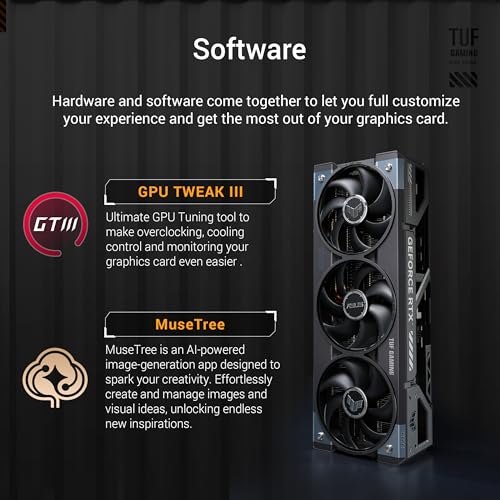ASUS TUF Gaming GeForce RTX 5080 OC Edition Technical Review: The New Vanguard of Performance and Durability
Introduction: The Dawn of a New Architectural Era in PC Gaming
In the relentless and exhilarating arms race of PC graphics technology, the arrival of a new GPU architecture from NVIDIA is not merely an event; it is a seismic shift that redefines the very boundaries of what is possible in gaming, content creation, and artificial intelligence. With the launch of the highly anticipated “Blackwell” architecture, the stage is set for a quantum leap in performance. It is upon this groundbreaking foundation that board partners like ASUS build their masterpieces, and among them, the “TUF Gaming” line has carved out a legendary reputation. It stands as a bastion of a core philosophy: delivering elite-tier performance that is fortified by an uncompromising commitment to durability, stability, and long-term reliability. The ASUS TUF Gaming GeForce RTX™ 5080 16GB GDDR7 OC Edition is the ultimate expression of this ethos, a card engineered not just to be fast, but to be unbreakable.
This is not simply a reference NVIDIA design with a different sticker. It is a ground-up re-engineering of the entire graphics card concept, a holistic system where the raw power of the RTX 5080 GPU is supported and amplified by a fortress of overbuilt hardware. ASUS has approached the TUF 5080 with a military-industrial design philosophy, meticulously selecting and validating every component—from the power-delivery capacitors to the thermal interface material—to meet standards that far exceed the baseline. It is a product built for the discerning enthusiast who understands that true performance is not just about peak frame rates on day one, but about consistent, stable, and cool operation through years of demanding use. It promises to harness the revolutionary capabilities of the Blackwell architecture and its accompanying DLSS 4 technology, all while being cooled by one of the most powerful and sophisticated thermal solutions ever deployed on a consumer graphics card.
This exhaustive technical review will perform a granular dissection of the engineering and material science that define the ASUS TUF Gaming RTX 5080. We will deconstruct the architectural advancements of the Blackwell GPU, analyze the complex algorithms behind DLSS 4, evaluate the real-world benefits of ASUS’s military-grade component selection, and delve into the fluid dynamics and thermodynamics of its massive 3.6-slot cooling system. This is a deep dive for the serious PC builder, the competitive gamer, and the creative professional who demands a tool that is as resilient as it is powerful. And with a limited-time 16% discount making this best-selling 2025 card more accessible, its position as a leader in rugged performance is undeniable.

A Deep Dive into the Key Features: A Component-by-Component Technical Analysis
The ASUS TUF Gaming RTX 5080’s flagship status is not derived from a single specification but from the synergistic interplay of NVIDIA’s cutting-edge silicon and ASUS’s uncompromising approach to hardware engineering. We will now dissect each core feature from a rigorous technical perspective.
-
The Heart of the Beast: The NVIDIA Blackwell Architecture and DLSS 4
The foundational element of this graphics card is its GPU, built on the next-generation **NVIDIA Blackwell architecture**. A new architecture represents a fundamental redesign of the GPU’s core components, including the Streaming Multiprocessors (SMs), RT Cores (for ray tracing), and Tensor Cores (for AI and DLSS). While specific details remain under wraps until the official launch, a new architecture from NVIDIA historically delivers a massive generational leap in several key areas. From a technical standpoint, users can expect a significant increase in both rasterization performance (traditional gaming) and, more importantly, ray tracing performance. Blackwell will feature next-generation RT Cores, which will be able to calculate the physics of light—reflections, refractions, and shadows—with far greater efficiency, allowing for more complex and realistic real-time ray-traced environments at higher frame rates.
The most transformative feature enabled by this new architecture will be **DLSS 4 (Deep Learning Super Sampling)**. DLSS is a revolutionary suite of AI-powered graphics technologies. Its core components are:
- Super Resolution: The game is rendered at a lower internal resolution (e.g., 1080p), and then NVIDIA’s AI model, running on the GPU’s dedicated Tensor Cores, intelligently reconstructs the image to a higher output resolution (e.g., 4K). DLSS 4 will use a more advanced neural network, trained on a larger dataset, to produce an upscaled image that is often visually indistinguishable, or even sharper, than a native resolution image, while providing a massive performance boost.
- Frame Generation: This is the key to the most dramatic performance gains. The AI analyzes two sequential, rendered frames and uses motion vector data to generate an entirely new, intermediate frame. This can effectively double the frame rate. DLSS 4 is expected to feature a more sophisticated frame generation algorithm that reduces latency and further improves the quality of the generated frames.
- Ray Reconstruction: A neural network that intelligently replaces hand-tuned denoisers for ray-traced lighting, resulting in a much higher-quality and more accurate final image.
The RTX 5080, powered by Blackwell and DLSS 4, is engineered to be a 4K high-refresh-rate gaming monster, capable of delivering unprecedented frame rates with full ray tracing enabled, an experience that is the holy grail of modern PC gaming.

-
The Foundation of Stability: Military-Grade Components and Power Delivery
The “TUF” in TUF Gaming stands for The Ultimate Force, a branding that signifies a fanatical commitment to durability. This begins with the card’s **power delivery system (VRM)**, which is built using **military-grade components**. This is not a mere marketing term; it refers to components that are selected and tested to meet stringent standards for thermal tolerance, electrical stability, and longevity. The key components include:
- TUF Capacitors: The capacitors used in the VRM are certified to military-grade specifications. This means they are rated to operate flawlessly at higher temperatures and for a much longer lifespan (often 2.5x longer) than standard capacitors. From an electrical engineering standpoint, this provides a cleaner, more stable voltage supply to the GPU, which is critical for maintaining boost clocks under heavy load and for providing a stable platform for overclocking.
- TUF Chokes: The chokes (inductors) are also held to a higher standard, ensuring they can handle high currents with minimal power loss and without producing “coil whine,” an annoying high-pitched buzzing sound that can plague lesser cards under load.
- TUF MOSFETs: The MOSFETs (Metal-Oxide-Semiconductor Field-Effect Transistors) are the switches in the VRM. The military-grade components used here feature lower RDS(on) (on-state resistance), which means they are more efficient and generate less waste heat, contributing to the overall thermal stability of the card.
This “rock-solid power and longer lifespan” is the direct result of this overbuilt, high-quality power delivery system, providing the stable foundation needed to extract maximum performance from the powerful RTX 5080 GPU.

-
Environmental Fortification: Protective PCB Coating
ASUS has added a crucial layer of long-term protection with a **protective PCB coating**. From a materials science perspective, this is a **conformal coating**, a thin polymeric film that is applied to the printed circuit board (PCB) and conforms to its shape. This coating acts as a dielectric barrier, insulating the sensitive electronic components, solder joints, and conductive traces from the environment. Its primary purpose is to “protect against short circuits caused by moisture, dust, or debris.” In a high-airflow cooling system, dust and debris can accumulate on the PCB over time. In a humid environment, this dust can absorb moisture, creating a conductive path that can lead to a short circuit and catastrophic failure. The conformal coating provides a robust defense against this, as well as against accidental liquid spills or corrosion in high-humidity climates. It is a feature that significantly enhances the card’s long-term reliability and resilience.

-
The Science of Cool: 3.6-Slot Design, Vapor Chamber, and Axial-tech Fans
A GPU of this power class generates a tremendous amount of heat, and the TUF Gaming RTX 5080 employs a truly massive and sophisticated thermal solution. The foundation of this is the **3.6-slot design**. A standard “slot” on a PC case is approximately 20mm wide. A 3.6-slot design means the card’s cooler is over 70mm thick. This immense volume is dedicated to a **massive fin array**. From a thermodynamics perspective, the rate of heat dissipation is directly proportional to the available surface area. By making the heatsink thicker and wider, ASUS has dramatically increased the total surface area of the aluminum fins, providing a huge capacity to absorb and dissipate heat from the GPU.
The heat is transferred from the GPU die to this fin array via a high-performance **vapor chamber**. A vapor chamber is a phase-change cooling technology. It is a flat, sealed copper plate containing a small amount of a working fluid. The heat from the GPU causes this fluid to vaporize directly underneath it. The hot vapor then rapidly expands to fill the entire chamber, spreading the heat evenly across its entire surface. As the vapor reaches the cooler top surface of the chamber (which is in contact with the heatpipes), it condenses back into a liquid, releasing its latent heat. The liquid is then returned to the hot spot via a wick structure, and the cycle repeats. This process is vastly more efficient at spreading heat over a large area than a solid copper plate, ensuring the entire heatsink is utilized effectively.
This massive heatsink is ventilated by **three Axial-tech fans**. These are not standard fans. From an aerodynamics standpoint, they are designed for high static pressure. They feature a smaller fan hub, which allows for longer blades. The blades themselves are connected at their tips by a **barrier ring**. This ring reduces turbulence and focuses the air column downwards. This design is optimized to force a large volume of air through the dense, high-resistance fin array, ensuring that the heat is efficiently carried away from the card. The fans also typically feature a dual ball bearing design for a longer lifespan and a 0dB mode where the fans stop spinning completely during low-load, low-temperature situations for silent operation.

-
Long-Term Thermal Integrity: The Phase-Change GPU Thermal Pad
The crucial link between the GPU die and the vapor chamber is the Thermal Interface Material (TIM). While many cards use traditional thermal paste, the TUF 5080 utilizes a superior **phase-change GPU thermal pad**. From a material science standpoint, a phase-change material is a solid at room temperature but is designed to soften and flow at a specific activation temperature (typically around 45-50°C). When your GPU heats up during a gaming session, the pad softens into a grease-like consistency. This allows it to flow and fill in the microscopic air gaps and imperfections on the surface of the GPU die and the cooler base, ensuring “optimal thermal performance” through maximum surface contact. The key advantage over traditional thermal paste is its long-term stability. Under the intense and repeated thermal cycling (heating up and cooling down) of a high-end GPU, traditional thermal paste can dry out, crack, and be “pumped out” from between the die and the cooler over time, leading to a degradation of thermal performance. The phase-change pad is far more resilient to this phenomenon. It re-solidifies when the card cools, but it does not dry out or degrade in the same way, ensuring that it “outlasts traditional thermal paste” and maintains its high thermal conductivity for the entire lifespan of the card, even “under heavy loads.”

Pros: The Undeniable Technical Strengths of the TUF Gaming Philosophy
- Flagship-Level Generational Performance: Powered by the next-gen NVIDIA Blackwell architecture and DLSS 4 for a quantum leap in 4K ray tracing and AI-accelerated gaming.
- Uncompromising Durability and Stability: The use of military-grade capacitors, chokes, and MOSFETs in the power delivery system ensures rock-solid power, lower temperatures, and a significantly longer lifespan.
- Exceptional Cooling Performance: The massive 3.6-slot design with a vapor chamber, a huge fin array, and high-static-pressure Axial-tech fans provides an elite-tier thermal solution that keeps the GPU cool and quiet under load.
- Superior Long-Term Reliability: The protective PCB conformal coating and the phase-change thermal pad are premium features that provide robust protection against environmental factors and thermal degradation over years of heavy use.
- Future-Proof Connectivity: Features the PCIe 5.0 interface for maximum bandwidth and next-generation display outputs like DisplayPort 2.1, ready for the future of high-refresh-rate 4K and 8K monitors.
- OC Edition for Out-of-the-Box Performance: As an “OC Edition,” it comes with a factory overclock for higher boost clocks and better performance than the reference NVIDIA model, right out of the box.

Cons: Important Technical Considerations and Limitations
- Extreme Physical Size: The 3.6-slot design makes this a very large and thick graphics card. It will not fit in many Small Form Factor (SFF) or even some mid-tower PC cases. Buyers must meticulously check their case clearance dimensions before purchasing.
- High Power Consumption: An RTX 5080-class GPU will have a high Total Board Power (TBP). This will require a high-quality, high-wattage power supply unit (PSU), likely 850W or higher, with the correct PCIe 5.0 12VHPWR power connectors.
- Premium Price Point: As a high-end, custom-designed version of a flagship GPU, it will command a significant price premium, placing it firmly in the enthusiast and professional budget category.
- Potential for GPU Sag: Due to its significant weight and size, the card may be prone to “GPU sag” over time. The use of a GPU support bracket (often included with the card or available separately) is highly recommended to prevent stress on the PCIe slot.
Conclusion: The Unbreakable Juggernaut of High-Performance Gaming
The ASUS TUF Gaming GeForce RTX™ 5080 OC Edition is a truly formidable piece of hardware and a powerful embodiment of the TUF Gaming ethos. It is a product that takes the monumental performance potential of NVIDIA’s Blackwell architecture and fortifies it with a level of engineering rigor and component quality that is second to none in its class. This is not a card for the builder who prioritizes flashy RGB over fundamental stability; it is a card for the discerning enthusiast who understands that true, lasting performance is built on a foundation of uncompromising quality. Every aspect of its design, from the military-grade power delivery to the sophisticated, overbuilt thermal system, is a testament to a philosophy that prioritizes resilience and longevity.
The performance enabled by the RTX 5080 and DLSS 4 will undoubtedly be breathtaking, but the true value of the TUF Gaming model is the peace of mind that comes from owning a product that is engineered to endure. While its massive size and significant power requirements demand a well-planned system build, the return on that investment is a GPU that will run cooler, quieter, and more reliably for years to come. For the serious gamer, the demanding content creator, or the professional who needs a graphics card that is as dependable as it is powerful, the ASUS TUF Gaming RTX 5080 is not just one of the best choices for the 2025 season; it is the definitive choice for those who believe that durability is the ultimate performance metric.
Frequently Asked Questions (FAQs)
- Q1: What is the main technical difference between this TUF Gaming card and an ASUS ROG Strix card?
- A: Both are flagship lines, but with different philosophies. The ROG Strix line typically represents the absolute peak of performance and features, often with a more aggressive factory overclock, a more complex power delivery system for extreme overclocking, and more extensive RGB lighting. The TUF Gaming line prioritizes extreme durability and reliability, using military-grade certified components and a robust, functional design, often at a slightly more accessible price point than the Strix. Think of Strix as a Formula 1 car and TUF as a high-performance armored vehicle.
- Q2: What is GDDR7 memory and how is it better than GDDR6X?
- A: GDDR7 is the next generation of graphics memory. Its primary technical advantage is a massive increase in data transfer speeds (bandwidth). It achieves this by using a new signaling technology called PAM-3 (Pulse-Amplitude Modulation with 3 levels), which can transmit more data per clock cycle than the PAM-2/NRZ used in older GDDR generations. For the RTX 5080, this means the GPU will have much faster access to the 16GB of video memory, which is critical for reducing loading times and enabling smooth performance at very high resolutions like 4K and 8K with large textures.
- Q3: What is DisplayPort 2.1 and why is it an important future-proofing feature?
- A: DisplayPort 2.1 is the latest version of the DisplayPort video interface. Its key advantage is a massive increase in bandwidth over DisplayPort 1.4a. This allows it to support much higher resolutions at higher refresh rates without using compression. For example, DP 2.1 can support uncompressed 4K at 240Hz, or even 8K at 85Hz. While monitors that can take full advantage of this are still emerging, having DP 2.1 on the RTX 5080 ensures that your graphics card is ready for the next generation of ultra-high-performance gaming displays.
- Q4: Do I need a new motherboard with PCIe 5.0 to use this graphics card?
- A: No, you do not. The PCIe (PCI Express) interface is fully backward compatible. You can install this PCIe 5.0 graphics card into a motherboard with a PCIe 4.0 or even a PCIe 3.0 slot, and it will work perfectly. It will simply operate at the maximum speed of the slot it is in. While a PCIe 5.0 slot provides the maximum theoretical bandwidth, the real-world gaming performance difference between a 5.0 and 4.0 slot is currently negligible for a single GPU.
- Q5: What is a “vapor chamber” and how is it technically better than a standard copper baseplate on a cooler?
- A: A standard baseplate relies on conduction to move heat to the heatpipes, which can lead to hot spots. A vapor chamber is a more advanced phase-change cooling technology. It is a sealed, flat chamber that uses a liquid-to-vapor cycle to absorb heat from the GPU die and spread it with extreme speed and efficiency across the entire surface of the chamber. This provides a much more uniform heat transfer to the heatpipes, making the entire heatsink work more effectively and leading to lower overall GPU temperatures.
- Q6: How does the “OC Edition” technically differ from a standard RTX 5080?
- A: The “OC Edition” means the card ships from the factory with a guaranteed, higher boost clock speed than the reference specification set by NVIDIA. ASUS tests and validates the GPUs (a process called “binning”) and selects the highest-quality chips for their OC models. This means you get a slight but noticeable performance increase right out of the box, without having to do any manual overclocking yourself. The robust TUF cooler and power delivery are designed to easily handle this higher clock speed.
See more posts in the category Computers.







